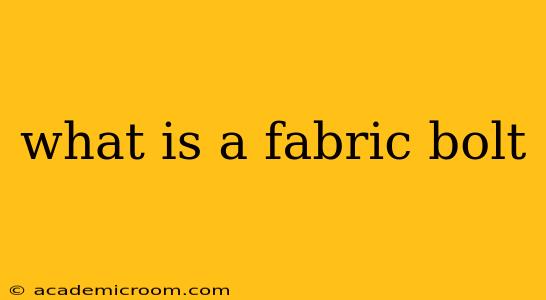A fabric bolt, also known as a fabric roll, is a large, tightly wound roll of woven or knitted fabric. It's the standard way fabric is packaged for wholesale and often retail sale. Think of it like a giant spool of thread, but instead of thread, it's a continuous length of cloth. Understanding what constitutes a fabric bolt is key for anyone working with textiles, from designers and sewers to retailers and wholesalers.
What does a fabric bolt look like?
Fabric bolts typically consist of a substantial amount of fabric wound onto a sturdy cardboard tube or core. The amount of fabric can vary greatly, depending on the type of fabric and the manufacturer's specifications. You might find bolts ranging from a few yards to hundreds of yards of fabric. The fabric is tightly wound to prevent wrinkles and damage during shipping and storage. Often, the outer layer will be wrapped in protective paper or plastic. The bolt itself is generally quite heavy, especially for heavier fabrics.
How much fabric is on a bolt?
The yardage of fabric on a bolt is highly variable. This depends on several factors:
- Fabric type: Heavier fabrics, like denim or upholstery fabrics, will typically have fewer yards per bolt than lighter fabrics, such as cotton voile or chiffon. This is due to the weight and bulk of the material.
- Manufacturer: Different manufacturers have varying standards for how much fabric they roll onto a bolt.
- Retailer: Some retailers might sell bolts in smaller quantities, such as half-bolts or quarter-bolts, tailored to individual crafting projects.
What are fabric bolts used for?
Fabric bolts serve as the foundation of the textile industry, supporting a wide variety of uses:
- Wholesale and Retail Sales: The primary purpose of fabric bolts is to efficiently transport and sell large quantities of fabric. Fabric stores often display bolts directly to customers, allowing them to browse and select the fabric they need.
- Manufacturing: Garment factories and other textile manufacturers use fabric bolts as their raw material for large-scale production.
- Home Sewing and Crafting: While typically not purchased in the same quantity as by manufacturers, individual sewers and crafters can purchase fabric bolts for large projects or to stock up on favorite fabrics.
- Quilting and Upholstery: Fabric bolts of quilting cotton or upholstery fabrics are essential for larger projects that require substantial yardage.
What are the advantages of buying fabric from a bolt?
There are several benefits to purchasing fabric from a bolt rather than pre-cut lengths:
- Cost Savings: Often, buying fabric in bulk from a bolt is more economical than purchasing pre-cut pieces, especially for large projects.
- Choice and Availability: Bolts offer a wide selection of colors, patterns, and fabrics in one location. You have more freedom to choose exactly the amount you need.
- Consistency: Buying from a single bolt ensures color consistency throughout your project, avoiding potential variations that could arise from using multiple pre-cut pieces.
How to handle and store a fabric bolt?
Proper handling and storage are vital to maintain the quality of the fabric on a bolt. Here are some tips:
- Unroll slowly and carefully: Avoid rapid unrolling, which can damage the fabric.
- Store in a cool, dry place: Protect the fabric from moisture, direct sunlight, and extreme temperatures.
- Avoid crushing or excessive pressure: Store bolts upright to prevent deformation.
Understanding fabric bolts and their uses is essential for anyone involved in the textile industry or who works with fabrics on a regular basis. By knowing what to look for and how to handle them properly, you can ensure you are getting the best quality fabric for your needs.
